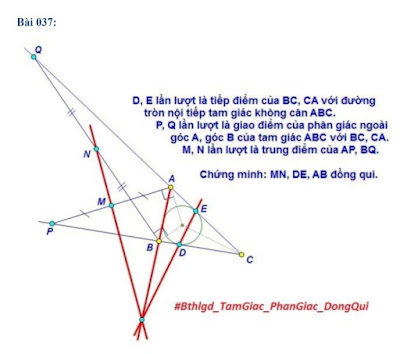Problem. Let $ABC$ be a triangle. Let $A'$ be on $BC$ such that $AA'$ is an internal angle bisector. Call $M$ the midpoint of $AA'$. Let $T$ be the point of tangency of $BC$ with the $A$-excircle. Prove that the Spieker center of $ABC$ lies on $MT$.
Proof. Let $D$, $E$ and $F$ be the midpoints of sides $AC$, $AB$ and $BC$, respectively. Let the angle bisector of $\angle{EDF}$ intersect $ET$ in $D'$ and $BC$ in $D''$. Similarly, let the angle bisector of $\angle{DEF}$ intersect $DT$ in $E'$, $AC$ in $E''$ and $BC$ in $E^*$. Call $S$ the intersection of $DD'$ and $EE'$. Since $AB\parallel{DF}$, a simple angle chase lead us to conclude that $\triangle{FDD''}$ is isosceles with $FD=FD''$. Moreover, since $DE\parallel{D''T}$ it follows that $\triangle{EDD'}\sim{\triangle{TD'D''}}$, from which we have
\[\frac{ED'}{D'T}=\frac{DE}{D''T}=\frac{DE}{D''F+FT}=\frac{\frac{a}{2}}{\frac{c}{2}+\frac{a}{2}-(s-b)}=\frac{a}{b}.\tag{1}\]An analogous reasoning lead us to conclude that $\triangle{DEE''}$ is isosceles (with $DE=DE''$) and $\triangle{DEE'}\sim{\triangle{TE'E^*}}$, from which we obtain
\[\frac{TE'}{E'D}=\frac{TE^*}{ED}=\frac{CT+CE^*}{ED}=\frac{CT+CE''}{ED}=\frac{(s-b)+\frac{b}{2}-\frac{a}{2}}{\frac{a}{2}}=\frac{c}{a}.\tag{2}\]Now, since $BC$ is the homothetic image of $ED$ with scale factor $2$, then $M$ must lies on $DE$ and by the Angle Bisector Theorem,
\[\frac{DM}{ME}=\frac{AD}{AE}=\frac{b}{c}.\tag{3}\]
We want to show that $EE'$, $DD'$ and $MT$ are concurrent, so by invoking the Ceva's Theorem and substituting from $(1, 2, 3)$,
$$\frac{ED'}{D'T}\cdot{\frac{TE'}{E'D}}\cdot{\frac{DM}{ME}}=\frac{a}{b}\cdot{\frac{c}{a}}\cdot{\frac{b}{c}}=1.$$
This means $EE'$, $DD'$ and $MT$ are concurrent at $S$. Hence $S$ lies on $MT$.
$\square$

